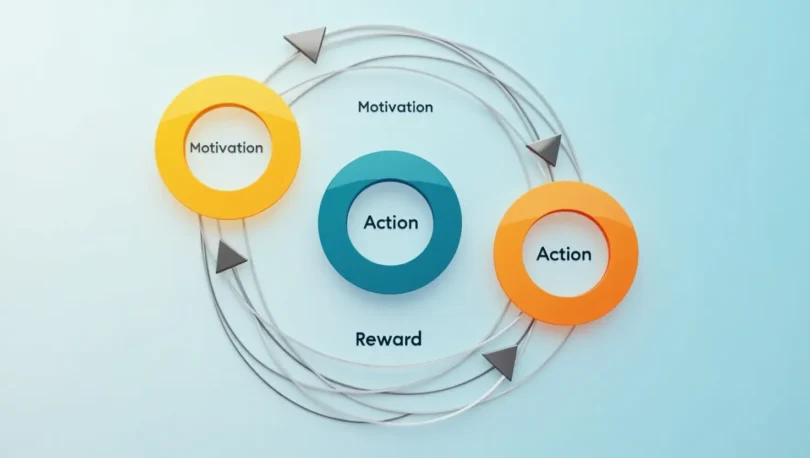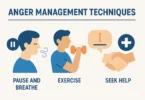Ever noticed how one small win can spark a wave of motivation that keeps you going all day? That’s not just a fluke — it’s the power of a positive feedback loop at work. These loops are like emotional fuel for your growth engine: once activated, they build momentum, motivation, and massive shifts in behavior.
In a world full of distractions and quick fixes, understanding how to intentionally trigger your own motivation cycle gives you a major edge. And it all starts with emotion. When you know how to harness your feelings — pride, joy, connection, or even curiosity — you can transform your habits, your mindset, and ultimately, your life.
In this post, we’ll dive into the science of positive feedback loops and reveal 8 emotional triggers that can ignite lasting change. Whether you’re building better habits, improving mental health, or chasing a goal, this guide will help you leverage the psychology behind motivation and momentum — and make growth feel natural.
Table of contents
Understanding the Positive Feedback Loop in Personal Growth
- What Is a Positive Feedback Loop?
- How Positive Feedback Loops Influence Behavior
- Why Positive Feedback Loops Matter for Mental Health
Positive Feedback Loop: 8 Emotional Triggers That Fuel Growth
How to Build Your Own Positive Feedback Loop for Lasting Change
- Start Small: The Power of Tiny Wins
- Identify and Leverage Your Emotional Triggers
- Track Progress and Celebrate It
Understanding the Positive Feedback Loop in Personal Growth
Creating change that sticks isn’t about pushing harder — it’s about working smarter. When you intentionally design your own positive feedback loop, you stop relying on willpower and start riding momentum. This is where transformation happens. In the next few sections, we’ll break down simple, science-backed steps to help you build a loop that fuels motivation, reinforces progress, and keeps you moving forward — even on the tough days.
What Is a Positive Feedback Loop?
A positive feedback loop is a self-reinforcing cycle — where one good action or result leads to another, and then another, creating a momentum that keeps building on itself. Think of it like rolling a snowball down a hill. It starts small, but with every turn, it picks up more snow, more speed, and more power.
In psychology and behavior science, this concept is deeply tied to how our brains form habits, respond to rewards, and build motivation. When you do something that feels good — like completing a task, hitting a fitness goal, or even getting a compliment — your brain releases dopamine, a “feel-good” chemical. That dopamine rush makes you want to repeat the behavior. And when you do, the loop strengthens.
So, the more you repeat the behavior, the more your brain wires it in as a positive pattern — this is where neuroplasticity comes in. It’s your brain’s ability to reshape itself based on repeated experiences.
Let’s make it real with an example:
Imagine you start jogging in the mornings. At first, it’s tough. But after a few runs, you begin to feel more energetic. You sleep better. You get compliments. That triggers joy, pride, and even a sense of control over your life. Boom — the loop begins. The positive emotions reinforce the habit, making you want to keep going.
That’s the power of a positive feedback loop. It transforms effort into motivation, and motivation into growth — emotionally, mentally, and even physically.
How Positive Feedback Loops Influence Behavior
Positive feedback loops don’t just feel good — they actually shape the way we think, act, and grow over time. These loops are powerful mechanisms that fuel habit formation, strengthen motivation, and even rewire the brain to favor progress.
At the heart of it all is one simple idea:
What gets rewarded, gets repeated.
When you perform an action that brings a positive outcome — a sense of achievement, a compliment, a feeling of peace — your brain lights up. Neurotransmitters like dopamine flood your system, making you feel good. That “high” acts like a green light, telling your brain:
“Yes, do this again!”
Over time, this reinforcement becomes automatic. You’re no longer just doing the behavior consciously — it starts to feel natural. That’s how people develop routines like going to the gym, practicing gratitude, or meditating. What started as a decision turns into second nature through repetition and emotional reward.
Let’s break it down with a real-world scenario:
Say you’re building the habit of reading before bed. The first few nights feel forced. But then you notice you’re sleeping better. You wake up more refreshed. Maybe you even finish a book and feel proud. That inner satisfaction creates a feedback loop — your mind begins to link reading with reward. Eventually, you look forward to it.
This is also where behavioral psychology comes into play. The legendary psychologist B.F. Skinner talked about operant conditioning — the idea that behavior is shaped by its consequences. In the case of positive feedback loops, the consequence is a reward, and the reward strengthens the behavior.
What’s amazing is that emotions play a massive role in this. Positive emotions — like joy, pride, or fulfillment — act as behavioral fuel. They don’t just make us feel good in the moment; they make us want to chase that feeling again and again. That’s how a single good action can spiral into lasting transformation.
In short, positive feedback loops motivate, reinforce, and sustain. They influence how you behave today — and more importantly, who you become tomorrow.
Why Positive Feedback Loops Matter for Mental Health
Positive feedback loops aren’t just useful for productivity or habit-building — they play a profound role in your emotional and mental well-being. In fact, they may be one of the most underrated tools for nurturing a healthier, more resilient mind.
Emotional Well-Being: The Foundation of Stability
When you’re stuck in a negative spiral — stress, self-doubt, burnout — everything feels heavy. But just one uplifting experience can disrupt that downward cycle. A positive feedback loop, on the other hand, does the opposite: it pulls you upward. One small win, one burst of joy, one act of self-care… and suddenly, your mindset begins to shift.
The key? Positive emotion breeds more positive emotion.
When you feel good after doing something — like helping a friend, taking a deep breath, or reaching a goal — that feeling encourages more of the same behavior. And this emotional momentum fosters stability, inner peace, and even hope, all of which are essential to mental health.
Recommended: Mental Health Well-Being: Unlocking Peak Performance and Productivity
Motivation Cycles in Self-Improvement
Self-improvement isn’t about giant leaps. It’s about consistent, emotionally rewarding steps that form a loop:
Action → Reward → Motivation → Repeat.
Positive feedback loops are the engine behind this cycle. They remind you that your efforts matter, that progress is possible, and that you have the power to change. Every small achievement — even just waking up on time or journaling — can fuel the next one, creating a rhythm of motivation that sustains long-term growth.
This is why even the smallest daily wins are vital. They serve as emotional proof that you’re evolving — and that’s exactly what keeps you moving forward.
Neuroplasticity and Rewiring the Brain
Here’s where science gets beautifully poetic: your brain actually reshapes itself based on repeated thoughts, emotions, and behaviors. This phenomenon is called neuroplasticity — the brain’s ability to reorganize neural pathways.
When you continuously engage in positive behaviors that feel good, you’re not just creating habits — you’re literally rewiring your brain to default to healthier, more empowering patterns. Each time you complete a self-affirming action and feel rewarded, those brain circuits get stronger.
That means the more you reinforce self-love, calm, joy, or gratitude, the easier it becomes to access those emotional states. Over time, your mind becomes better at coping, healing, and bouncing back from setbacks.
In essence, positive feedback loops are nature’s way of helping us heal, grow, and thrive. They align your emotions, behaviors, and brain chemistry to support a happier, healthier version of yourself.
Positive Feedback Loop: 8 Emotional Triggers That Fuel Growth
We often think change comes from discipline or strategy — but more often, it’s emotion that drives transformation. Emotional triggers have the power to start, maintain, and strengthen positive feedback loops. They act like internal signals, telling your brain,
“This feels good — let’s keep going.”
Below are eight powerful emotional triggers that can create momentum, reinforce good habits, and accelerate your personal growth.
1. Joy – The Spark That Keeps You Going
Joy is light, vibrant, and contagious. When a task brings you joy — whether it’s writing, creating, moving your body, or helping someone — you’re naturally inclined to do it again.
This repeated action becomes a self-sustaining cycle. Even the anticipation of joy can trigger the loop, giving you something to look forward to and pushing you into action.
Pro tip: Notice what makes you smile effortlessly. Lean into those moments — they’re your emotional fuel.
2. Curiosity – Igniting a Cycle of Learning and Action
Curiosity is one of the most powerful motivators. It pulls you forward with questions: What if? Why? How?
When you’re curious, you’re willing to explore, to try, to learn. That exploration often leads to small wins and insights — which then spark even more curiosity.
In practice: Whether it’s reading a book, watching a documentary, or trying a new hobby, curiosity invites growth by encouraging repeated engagement.
3. Pride – Building Confidence Through Progress
When you feel proud of yourself — for showing up, staying consistent, or overcoming fear — it lights a fire inside. Pride is a proof of progress. And that proof feeds your motivation loop.
Each small success becomes a reference point:
“I did it once. I can do it again.”
Over time, this self-pride compounds and builds real confidence.
4. Gratitude – Reinforcing Positivity and Purpose
Gratitude shifts your focus from what’s missing to what’s working. It’s not just a feel-good emotion — it’s a mental lens that rewires your brain toward positivity and abundance.
When you practice gratitude regularly, you start noticing the good more often. That awareness reinforces behaviors and choices that bring those good feelings. Boom — another feedback loop is born.
Try this: End your day by writing down 3 things you’re grateful for. Watch how it changes your outlook — and your actions.
5. Hope – Creating Momentum Toward a Better Future
Hope is forward-focused. It’s the belief that things can get better, that growth is possible, that you have power.
When hope is present, it lifts you out of stagnation and nudges you to take action. That first action — no matter how small — creates a ripple that builds momentum.
Hope turns “I wish” into “I’m working on it.”
6. Love – Deep Emotional Connection to Goals
Whether it’s love for yourself, your family, your craft, or your purpose — love is a deep motivator that gives your actions meaning.
When your goals are emotionally connected to what (or who) you love, they stop being just checklists. They become part of your identity. That connection fuels consistent effort and passion.
Love makes you show up — even on the hard days.
7. Fulfillment – Satisfaction That Drives Continuity
Fulfillment is the reward that lingers. It’s the feeling of alignment — like your actions actually matter, like you’re becoming who you’re meant to be.
Unlike quick dopamine hits, fulfillment creates long-lasting satisfaction, which is essential for long-term positive feedback loops.
It says: This is worth continuing. This is right.
8. Excitement – Fueling Passion and Forward Motion
Excitement is energy. It grabs your attention, raises your heart rate, and pulls you into the moment. When you’re excited about something, you’re willing to work harder, focus deeper, and risk more.
Excitement doesn’t guarantee success — but it guarantees effort, which is often half the battle in any feedback loop.
Final Thought:
Each of these emotions can be a spark that lights up your personal growth loop. The secret is to pay attention. When something feels energizing or emotionally rewarding — take note.
That’s your brain’s way of saying, “This is good for you. Do more of this.”
In the end, growth isn’t just a goal. It’s a cycle — fueled by how you feel and how often you feed those feelings.
How to Build Your Own Positive Feedback Loop for Lasting Change
Understanding the theory behind positive feedback loops is one thing — building one into your daily life is where real growth begins. Lasting change doesn’t happen by accident; it happens when small wins, emotional triggers, and intentional actions work together in a loop that fuels itself. In this section, you’ll learn how to design your own system — one that turns good habits into second nature and keeps you motivated long after the initial excitement fades.
Start Small: The Power of Tiny Wins
When we think about personal growth, it’s easy to imagine big breakthroughs — quitting a job, losing 30 pounds, publishing a book. But in reality, lasting transformation starts much smaller. It’s the tiny, almost invisible wins that quietly stack up and change the game over time.
Use Behavioral Psychology to Shape Habits
Behavioral psychology teaches us that the size of the action matters less than the consistency behind it. According to B.J. Fogg, a leading researcher in habit formation, the secret is to go tiny. Why? Because small behaviors are easy to do, require little motivation, and are more likely to stick.
These small wins create positive feedback loops by triggering a sense of success. Even something as simple as checking a box or completing a micro-task gives the brain a dopamine hit — a reward. That reward reinforces the behavior and makes it more likely you’ll do it again tomorrow.
Psychologists call this success momentum. Once you get a taste of progress, your motivation grows. And motivation fuels more action — which leads to more wins. This loop builds quietly but powerfully until one day, the change feels effortless.
Examples of Tiny Wins That Add Up
- Daily journaling: Just jotting down 1–2 sentences a day about your thoughts, gratitude, or goals can shift your mindset. You don’t need to write a novel — just show up for the page. Over time, you’ll gain insight, clarity, and emotional balance.
- Short workouts: Moving your body for just 5–10 minutes — stretching, walking, or doing a few push-ups — sends a message: “I care about my health.” This consistent act trains your brain to associate movement with reward, building a loop of self-respect and vitality.
- Mindful breathing: A single minute of deep breathing in the morning can calm your nervous system and center your mind. That peace becomes a positive anchor — one you’ll want to return to each day.
- Tidying a small space: Cleaning your desk or making your bed might seem minor, but the sense of control it gives you creates a small burst of pride. That’s the emotional push that keeps you improving your environment.
The Takeaway
You don’t need a massive plan or perfect motivation. You just need a starting point.
A single small action, repeated with intention, creates a ripple effect.
It shifts your identity from “I want to change” to “I am changing.”
Tiny wins build trust in yourself — and that trust? That’s where true transformation begins.
Identify and Leverage Your Emotional Triggers
Every lasting behavior starts with a feeling. Whether it’s the calm after a walk, the rush after finishing a task, or the pride from keeping a promise to yourself — your emotions are signals. They guide you, drive you, and if you’re aware enough, they can fuel powerful positive feedback loops.
But here’s the catch: most people don’t pay attention to what really moves them.
Recognize What Feelings Motivate You
We’re all wired differently. For one person, the emotion of relief might spark action — like the feeling of inbox zero. For another, it could be excitement, the thrill of a challenge or something new. Others might be driven by connection, the warmth of engaging with someone they care about.
The key is to tune in.
Ask yourself:
- What emotions make me want to act?
- What activities leave me feeling proud, energized, calm, or fulfilled?
- What moments in my day give me a small “emotional high”?
Once you identify those feelings, you can start designing routines around them.
💡 Self-awareness is the first step in using emotion as a tool — not just an experience.
Link Emotion With Routine
Here’s where emotional intelligence meets habit formation. When you intentionally link a positive emotion to a specific behavior, you create an internal reward system. This is the fuel that powers your habit loop.
Let’s break it down:
- Love calm and clarity? Make mindful breathing or journaling part of your morning.
- Feel driven by accomplishment? Break big goals into micro-tasks so you’re always collecting small wins.
- Thrive on connection? Pair your self-improvement tasks with community — like a book club, fitness buddy, or mastermind group.
When the behavior becomes a consistent source of a good feeling, it becomes something you want to do — not just something you have to do.
Over time, this association between emotion and habit becomes automatic. You crave the feeling, so you naturally repeat the action. That’s the power of emotional triggers in motion.
The Bottom Line
If you want your habits to last, don’t just focus on what you do. Focus on how it makes you feel.
Because when emotion and action dance together, you don’t just build habits — you build momentum.
And that’s how growth becomes sustainable, even joyful.
Track Progress and Celebrate It
Progress is often more of a feeling than a tangible outcome. You might feel like you’re working hard, but if you don’t have clear evidence of your growth, it can feel like you’re not getting anywhere. This is where tracking and celebrating come into play — they are essential strategies for maintaining momentum and reinforcing positive feedback loops.
Use Tools Like Habit Trackers
One of the most effective ways to track progress is through habit tracking. Whether it’s a physical journal, a mobile app, or a simple calendar, habit trackers are designed to give you a visible, structured way to monitor your daily activities.
Why it works:
When you track your actions, you create a visual record of your efforts. This record acts as a powerful reminder of how far you’ve come. The act of checking off a box or marking a goal as completed gives your brain a hit of dopamine, a chemical associated with pleasure and reward.
The simplicity of seeing progress in action can be deeply motivating. It transforms the abstract concept of “growth” into a concrete, measurable result. And the more frequently you experience this dopamine release, the more likely you are to stick with the habit.
Tools you can use:
- Apps like Habitica, Streaks, or Productive are all excellent for tracking habits and rewarding progress.
- Physical planners or bullet journals can also be great — especially when paired with stickers or colored markers for a visual cue.
The beauty of habit trackers is that they don’t just measure whether you’re succeeding; they give you a reason to celebrate the process, not just the end result.
Dopamine Release from Visual Progress
One of the most powerful motivators in human psychology is the dopamine loop — the way your brain rewards you for completing tasks, big or small. When you track progress and visually see your achievements building up over time, you trigger this dopamine release repeatedly.
Why is this important?
- Dopamine makes you feel good, which strengthens your motivation to repeat the behavior.
- The more you see progress, the more your brain associates that feeling of satisfaction with the task itself.
For example, imagine you’re working on a fitness goal. You might not notice the gradual changes in your body day by day, but when you see a long streak of exercise days marked on your habit tracker, you feel pride. That pride releases dopamine, which in turn makes you excited to continue exercising the next day.
The power of visual progress:
- Satisfying streaks: The longer you keep a streak going, the more motivation you get to maintain it.
- Clear milestones: Tracking allows you to break down large goals into small, achievable milestones that feel incredibly rewarding.
- Instant feedback: Your tracker gives you immediate feedback on your success, reinforcing the behavior and creating a cycle of reinforcement.
Celebrate the Wins — Big or Small
Celebrating your progress isn’t just about the big wins. Every step forward deserves recognition, no matter how small. These celebrations, whether internal or external, help strengthen the positive feelings connected to your actions and create a sense of achievement.
Here’s how you can celebrate:
- Reward yourself: Whether it’s with a favorite treat, a relaxing activity, or some time off, make sure to celebrate when you hit milestones, even if they’re small.
- Reflect on growth: Take a moment to reflect on how far you’ve come, the obstacles you’ve overcome, and the progress you’ve made. This helps solidify the emotional connection to the habit.
- Share your success: Telling a friend or posting about it online can increase the emotional payoff, as others’ positive reactions will provide additional social reinforcement.
The Takeaway
Tracking and celebrating your progress doesn’t just keep you accountable — it triggers your brain’s reward system, reinforcing positive behaviors and encouraging continued growth. Whether you’re using an app or a simple calendar, visualizing success through tracking is a key tactic to keep the momentum going.
Remember, every small win deserves recognition. The more you acknowledge progress — no matter how minor it seems — the more ingrained your habits will become. And that’s the magic of a positive feedback loop in action.
Growth doesn’t have to be a grind. When you understand the mechanics of a positive feedback loop, you unlock a smarter, more sustainable way to level up your life. It’s not about willpower — it’s about wiring your mind and emotions to work for you, not against you.
By recognizing and leveraging emotional triggers like joy, pride, connection, and purpose, you turn ordinary habits into powerful routines. You create momentum that builds on itself — a loop where success breeds more success.
Start small, feel deeply, and track your wins. The loop is already inside you — you just need to switch it on.
Growth isn’t a destination — it’s a rhythm. Let your emotions lead the dance.








Leave a Comment